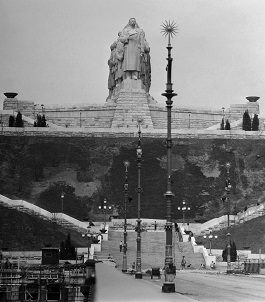
The Stalin monument stood in Letná for seven years
 |
The idea of erecting a monument to Stalin in Prague emerged soon after the end of World War II. There were several proposals for its location, and a special commission led by the Minister of Information Václav Kopecký preferred Letná, specifically a site near Hanavský Pavilion. Ultimately, however, the decision was made to build the monument a little further east, directly opposite the Čech Bridge.
The form of the monument was the result of an art competition announced in April 1949. From more than fifty submitted designs, the jury selected the study by architect Jiří Štursa, his wife Vlasta, and sculptor Otakar Švec for implementation. The winning team came up with the idea of a group statue, in which eight figures symbolizing the Czechoslovak and Soviet peoples were lined up behind Stalin. Due to the number of figures, the monument later became nicknamed the "line for meat," but the jurors were enthusiastic.
On December 22, 1949, Prime Minister Antonín Zápotocký laid the corner stone of the future monument. Actual construction work began in February 1952. Under the hands of six hundred builders, the largest group sculpture in Europe began to take shape. From a 15-meter-high pedestal, a Stalin who was half a meter taller looked down on Prague. The interior of the monument consisted of a reinforced concrete structure, which was clad with 235 granite blocks from northern Bohemian quarries. The monument weighed a total of 17,000 tons and its construction cost 140 million crowns.
Due to the statue's construction, the football club Slavia had to leave Letná and moved to Vršovice. Delays in construction meant that Stalin did not live to see the completion of his statue (he died in March 1953). However, neither did Otakar Švec, one of its co-creators, witness the ceremonial unveiling of the monument in May 1955, as he committed suicide a month earlier.
The proposal to gradually dismantle the work was rejected due to its complexity, so the statue was demolished on three occasions in the autumn of 1962. The demolition of the colossus began on October 19, 1962, and was completed on November 6, 1962.
Only the underground spaces of Stalin's monument remained, which served as storage until 1989. Shortly after the Velvet Revolution, a rock club was established here and the first private radio station in Czechoslovakia, today known as Radio 1, broadcast from this location. The first notable change was the installation of a giant pendulum by Vratislav Novák in 1991. In recent years, the city reinforced the ceiling slab of the lower part of the monument. The space is used by skateboarders and for recreation.
The visibly distant spot on the edge of the Letná Plain has also attracted the attention of advertising agencies several times. In September 1996, the organizer of Michael Jackson's Prague concert erected a life-sized statue of the singer here. Before the 1998 elections, the Civic Democratic Party placed a giant billboard on the pedestal of Stalin's monument. The face of its then-leader Václav Klaus was soon replaced by a similarly designed portrait of actor and satirist Petr Čtvrtníček.
The Australian company Underwater World planned to build a giant marine aquarium here. A competing bidder, the company Swarovski, wanted to construct an exhibition and social complex with a multimedia program. Another project from the Sika Interlab company envisioned an audiovisual scene that would connect the view of Prague with film images of the city's history and beauty. However, none of the mentioned variants came to fruition, nor did the plan for the construction of a pavilion for Mucha's Slavic Epic, which was discussed in 2010.
The English translation is powered by AI tool. Switch to Czech to view the original text source.
0 comments
add comment
Related articles
12
17.10.2022 | The monstrous statue of Stalin stood in Letná for seven years
0
27.11.2021 | Workers are finishing repairs on the stairs and surfaces of the former Stalin monument
0
26.09.2019 | <p>Thousands of people are requesting the preservation of open space at Prague's Stalin.</p>
0
25.10.2017 | Under the former monument to Stalin, an exhibition on the totalitarian regimes of the 20th century will be established
0
16.05.2016 | For the film Monstrum, a model of the Stalin monument will be constructed in Letná
0
28.04.2014 | After twenty years, the underground of the former Stalin monument will be opened
0
30.04.2010 | 55 years ago, Stalin's monument was ceremoniously unveiled at Letná
0
24.04.2006 | Photographs at Letná remind of the author of the Stalin monument












